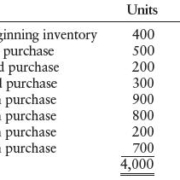ACC/557 Week 3 Chapter 4 (E4-5,E4-7,E4-13,P4-4A)
Exercise 4-5
The adjustments columns of the worksheet for Munoz Company are shown below
Adjustments
Account Titles Debit Credit
Accounts Receivable 600
Prepaid Insurance 400
Accumulated Depreciation—Equipment 900
Salaries and Wages Payable 500
Service Revenue 600
Salaries and Wages Expense 500
Insurance Expense 400
Depreciation Expense 900
2,400 2,400
Instructions:
(a) Prepare adjusting entries in order presented in the problem. (Credit account titles are automatically indented when amount is entered. Do not indent manually.)
(b) Indicate with an “X” the financial statement column to which each balance should be extended
Exercise 4-7
Lanza Company had the following adjusted trial balance.
LANZA COMPANY
Adjusted Trial Balance
For the Month Ended June 30, 2014
Account Titles Debit Credit
Cash 3,712
Accounts Receivable 3,904
Supplies 480
Accounts Payable 1,556
Unearned Service Revenue 160
Common Stock 4,000
Retained Earnings 1,760
Dividends 600
Service Revenue 4,300
Salaries and Wages Expense 1,344
Miscellaneous Expense 180
Supplies Expense 1,900
Salaries and Wages Payable 344
12,120 12,120
Instructions:
a. Prepare closing entries at June 30, 2014. (Credit account titles are automatically indented when amount is entered. Do not indent manually.)
b. Prepare a post-closing trial balance.
Exercise 4-13
Kogan Company has an inexperienced accountant. During the first 2 weeks on the job, the accountant made the following errors in journalizing transactions. All entries were posted as made.
1. A payment on account of $840 to a creditor was debited to Accounts Payable $480 and credited to Cash $480.
2. The purchase of supplies on account for $380 was debited to Equipment $38 and credited to Accounts Payable $38.
3. A $500 cash dividend was debited to Salaries and Wages Expense $500 and credited to Cash $500.
Instructions:
Prepare the correcting entries. (Credit account titles are automatically indented when amount is entered. Do not indent manually.)
Problem 4-4A
Excelsior Amusement Parkhas a fiscal year ending on September 30. Selected data from the September 30 worksheet are presented below.
Excelsior Amusement Park
Worksheet
For the Year Ended September 30, 2014
Trial Balance Adjusted Trial Balance
Dr. Cr. Dr. Cr.
Cash 34,400 34,400
Supplies 18,600 2,200
Prepaid Insurance 29,900 10,900
Land 80,000 80,000
Equipment 120,000 120,000
Accumulated Depreciation-Equip. 36,200 42,200
Accounts Payable 14,600 14,600
Unearned Ticket Revenue 3,900 1,000
Mortgage Payable 50,000 50,000
Common Stock 60,000 60,000
Retained Earnings 36,100 36,100
Dividends 14,000 14,000
Ticket Revenue 277,900 280,800
Salaries and Wages Expense 98,000 98,000
Maintenance and Repairs Expense 30,500 30,500
Advertising Expense 9,400 9,400
Utilities Expense 16,900 16,900
Property Tax Expense 21,000 24,000
Interest Expense 6,000 8,000
Totals 478,700 478,700
Insurance Expense 19,000
Supplies Expense 16,400
Interest Payable 2,000
Depreciation Expense 6,000
Property Taxes Payable 3,000
Totals 489,700 489,700
Instructions:
(a) Prepare a complete worksheet
(b) Prepare a classified balance sheet. (Note: $15,000 of the mortgage note payable is due for payment in the next fiscal year.) (List assets in order of liquidity and liabilities from largest to smallest eg 10, 5, 3, 2, with notes first.)
(c) Journalize the adjusting entries using the worksheet as a basis.
(d) Journalize the closing entries using the worksheet as a basis.
(e) Prepare a post-closing trial balance.





